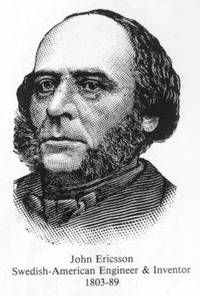
![]()
 The Caloric Ship Ericsson's Bell
The Caloric Ship Ericsson's Bellby Dick Slottow
One of the things I have always enjoyed about working with historical items has been the surprises that occur regularly. As an example, the next time you visit the Club take a look at the bell mounted outside the bar on the deck.
Overlooking the Bay with a great view of San Francisco's skyline is the bell from the old Caloric Ship Ericsson. No one seems to know how it arrived at the Club, but we do know something about the ship, and the man behind it.
John Ericsson was a brilliant Swedish engineer who had a lot of bad luck. In 1829 he designed a steam locomotive, the Novelty, to enter it in a speed competition. The Novelty was easily the fastest at 28 miles per hour, but its steam joints failed and the engine was destroyed. The slower Rocket won the competition by default.
Ericsson turned his efforts to the design of a screw propeller to replace the paddlewheels then in use. With some British lords and the Surveyor of the British Navy aboard, his screw propeller drove a boat up and down the Thames at the astonishing speed of 10 knots. Expecting accolades, Ericsson instead was rebuffed. "It can't possibly work", they objected, "to propel a ship from its stern", despite the evidence to the contrary.
 Furious, Ericsson emigrated to America, where his propeller had a friendlier reception. It was fitted on the ship Princeton, and was demonstrated with the Secretary of the U.S. Navy aboard. The propeller worked well, but the demonstration was marred when one of its guns exploded, killing the Secretary and several others. This disaster made him persona non grata for several years. Despite the bad will that was engendered, the U.S. later called upon him to build the armored ship the Monitor.
Furious, Ericsson emigrated to America, where his propeller had a friendlier reception. It was fitted on the ship Princeton, and was demonstrated with the Secretary of the U.S. Navy aboard. The propeller worked well, but the demonstration was marred when one of its guns exploded, killing the Secretary and several others. This disaster made him persona non grata for several years. Despite the bad will that was engendered, the U.S. later called upon him to build the armored ship the Monitor.
Recognizing the dangers of steam engines, Ericsson began development of a hot-air engine he called the "Caloric", named after the mysterious substance that scientists of the day thought made up heat. His engine operated by repeatedly heating and cooling the same volume of air. This external combustion engine is similar to the Stirling Cycle engine, a 19th century design which is having a 21st century technical renaissance.
In 1853 Ericsson launched the Caloric Ship Ericsson to demonstrate the use of the Caloric engine.

Incredibly, each cylinder was 14 feet in diameter and had a 6 foot stroke, and ran at 14 cycles per hour! Unfortunately the Ericsson proved to be much slower than steam powered ships of the time. In 1854 the ship sank in a squall off New York. It was raised quickly, but the Caloric engine was replaced with steam power, much to Ericsson's chagrin. After that the Ericsson had a long and curious life. Its steam engine was removed and it entered the West Coast service as a sailing ship, carrying cargo such as coal and grain. It sank to its final resting place in a storm off Vancouver Island in 1898.
The bell located on the CYC deck came from the Ericsson. Although we don't know how it got here, it is a unique piece of the Club's rich historical archives.